Key takeaways:
- Clean backend code enhances collaboration and long-term sustainability, reducing technical debt and errors.
- Consistent naming conventions improve code clarity and readability, facilitating better teamwork and maintenance.
- Effective error handling and comprehensive documentation contribute significantly to user experience and onboarding efficiency.
- Testing strategies like Test-Driven Development and Continuous Integration help catch issues early, ensuring the reliability of code.
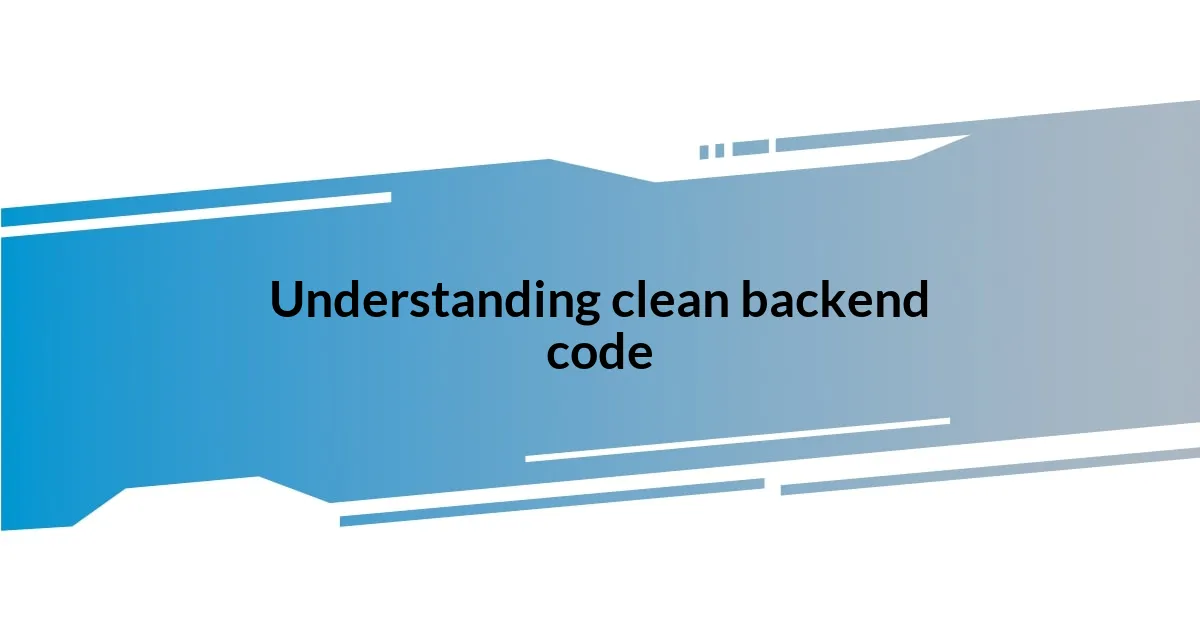
Understanding clean backend code
Clean backend code is more than just aesthetics; it’s about crafting a foundation that ensures your application runs smoothly. I remember a project where my messy code made it impossible to scale as user demands grew. This experience taught me that well-structured code not only aids in maintenance but also instills confidence in the development team.
When I think about clean backend code, I often reflect on how it affects collaboration. Have you ever struggled to understand a colleague’s code? I know I have, and it was a humbling moment that reinforced the value of clarity. Clean backend code promotes better communication and collaboration among team members, making it easier to onboard new developers.
Ultimately, understanding clean backend code means realizing its role in long-term sustainability. I’ve seen too many projects suffer due to haphazard coding practices, which often lead to technical debt and unnecessary headaches later on. Embracing cleanliness in code prevents these pitfalls and fosters an environment where innovation can thrive.
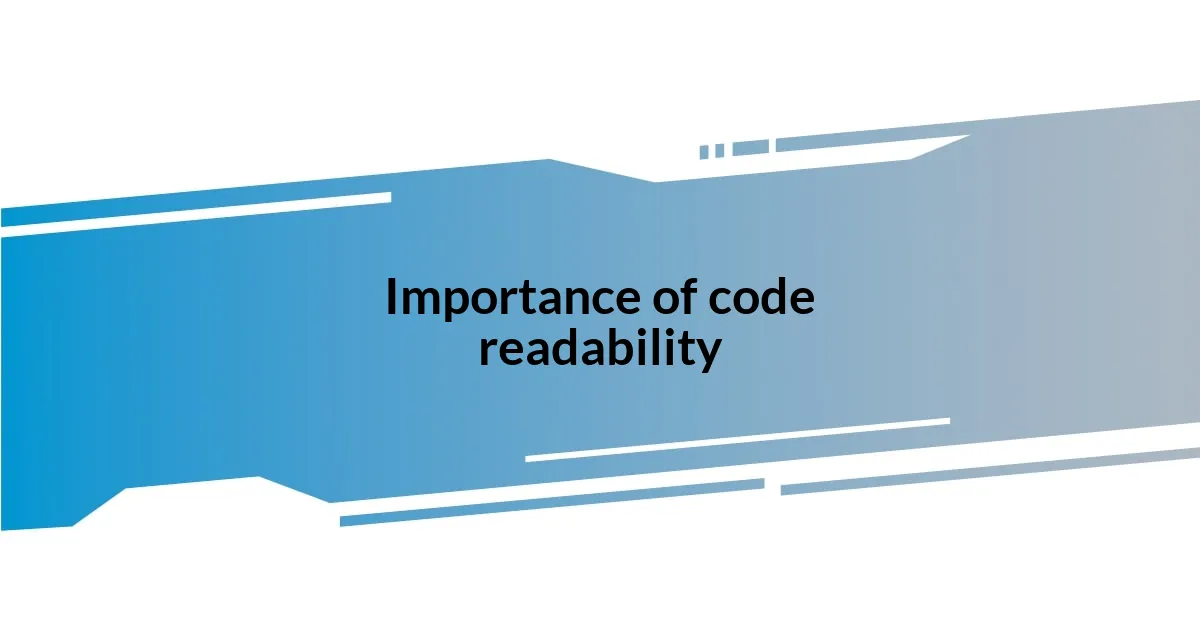
Importance of code readability
When I first ventured into backend development, I quickly discovered that readability is not just a nice-to-have; it’s essential. I remember reviewing code that was intended to handle critical transactions but was so convoluted that even the original author had trouble deciphering it. That experience underscored for me how readable code can save time, increase productivity, and significantly reduce the likelihood of errors.
Here are a few reasons why code readability is vital:
- Easier Debugging: When code is clear, finding and fixing issues becomes straightforward.
- Enhanced Team Collaboration: A team can work together more efficiently with code that everyone can understand.
- Faster Onboarding: New developers can get up to speed quickly when the code is well-organized and easy to read.
- Reduced Technical Debt: Readable code helps prevent future headaches by minimizing the accumulation of tricky, messy code over time.
- Improved Code Maintenance: Clear code simplifies future updates and modifications, ensuring long-term project sustainability.
In my experience, when I take the time to write clean, readable code, it feels like giving a gift to my future self and my team. The relief of returning to a well-structured codebase— where things make sense—is something I really cherish, especially when deadlines loom.
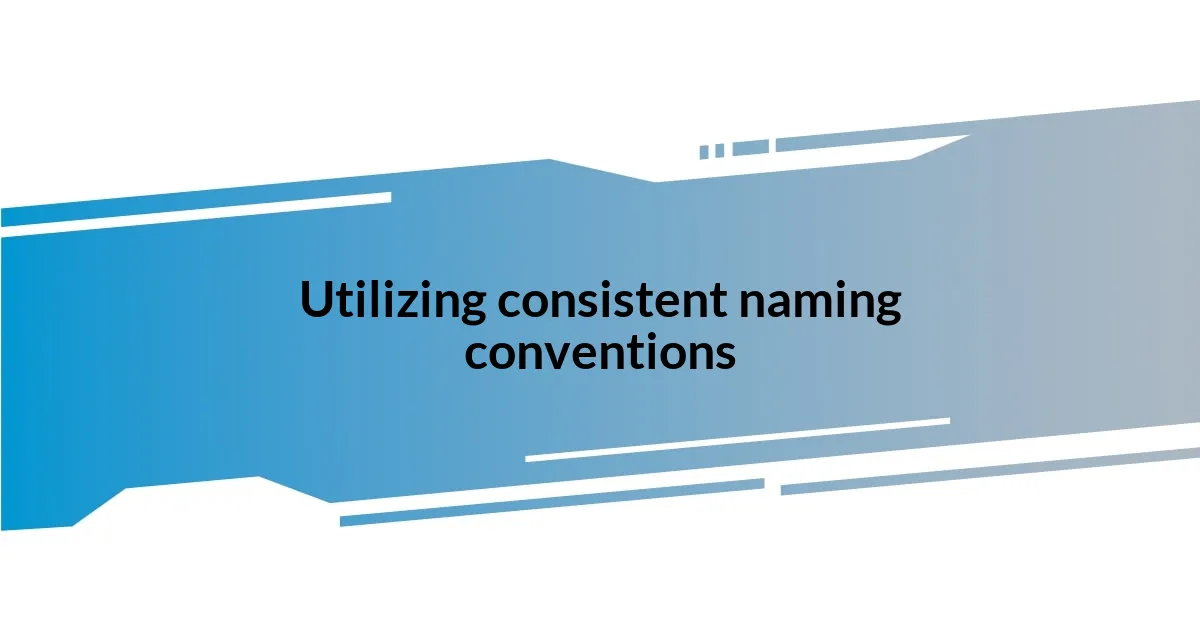
Utilizing consistent naming conventions
Utilizing consistent naming conventions is crucial in maintaining clean backend code. I once worked on a project where variable names were a mix of short forms and full words— it became a guessing game to figure out what each one represented. By adopting a consistent naming convention, I could have avoided the confusion. This practice not only improves clarity but also enhances the overall readability of the code.
Think about this: when you see a variable named userAge, it’s immediately clear what data it holds. In contrast, a name like ua leaves you scratching your head. I’ve learned that using descriptive names increases both my understanding and that of my teammates. It acts like a roadmap— guiding everyone through the code’s logic without unnecessary detours.
Implementing a straightforward naming convention across the entire codebase fosters teamwork and reduces the cognitive load on developers. I recall a particularly harrowing night spent debugging a feature, only to find that two similarly named functions did completely different things. Had we adhered to a set naming structure, that confusion could have been entirely avoided. Overall, consistent naming can transform how we interact with code, making every line more intentional and meaningful.
| Consistent Naming | Inconsistent Naming |
|---|---|
| Improved Clarity | Causes Confusion |
| Ease of Collaboration | Hampers Teamwork |
| Future-proof Maintenance | Leads to Technical Debt |
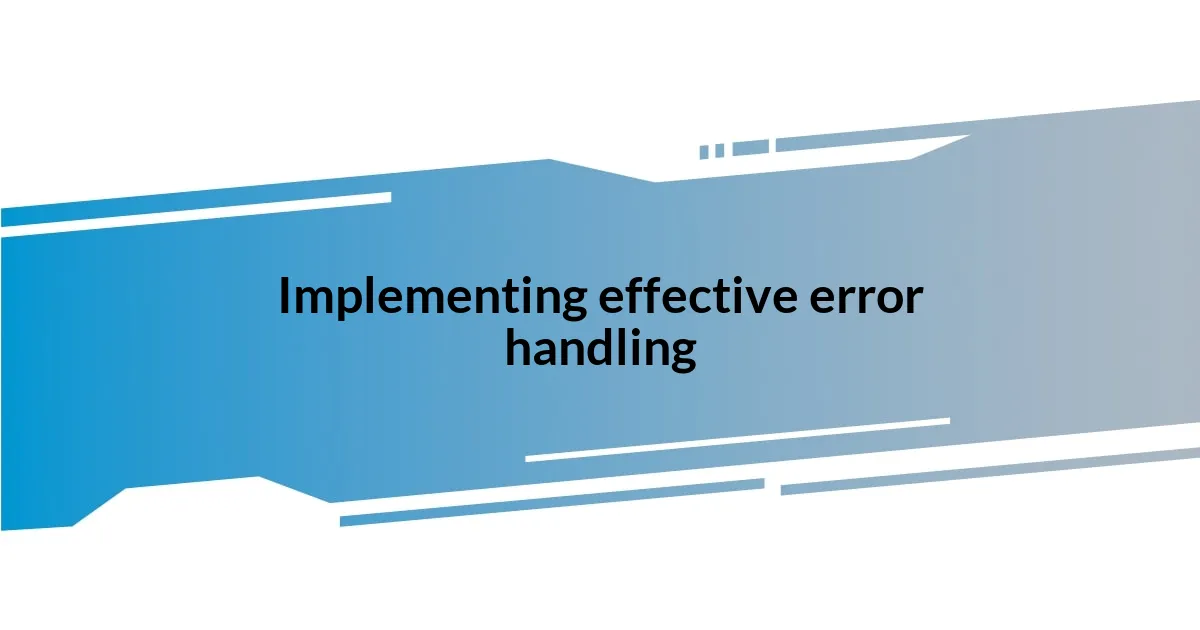
Implementing effective error handling
Effective error handling is more than just catching exceptions; it’s about creating an experience that fosters trust in your application. I recall a time when I deployed a feature without robust error handling in place. Users faced cryptic messages that did nothing to guide them, leading to frustration and a slew of negative feedback. That taught me that when errors occur, the goal should be to provide meaningful context, so users don’t feel lost.
I recommend implementing a structured approach to error logging. For instance, I once worked on a project where we used a centralized logging system to capture errors in real time. This not only helped us trace issues back to their origin quickly but also enabled us to analyze patterns over time. Have you ever had one of those “Eureka!” moments when a recurring error popped up, and you realized the fix was simpler than you thought? That’s the power of effective error handling—it transforms seemingly chaotic situations into manageable ones.
Lastly, consider how you present errors to your users. In one project, I opted for friendly user-facing messages instead of technical jargon. Instead of a vague “Error 404,” we displayed, “Oops! We can’t find that page.” This simple change made a significant difference; users felt more connected and less frustrated. Wouldn’t you agree that a little empathy in our error handling goes a long way in improving user experience? I firmly believe that thoughtful error management can set apart a great backend from an average one.
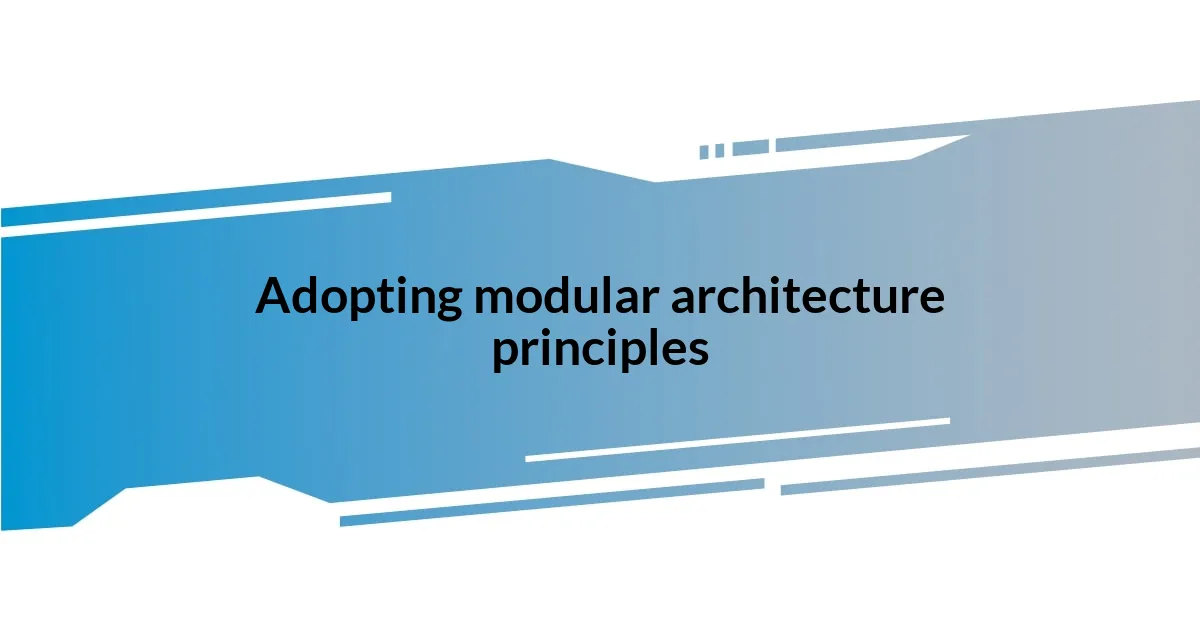
Adopting modular architecture principles
Adopting modular architecture principles has been a game changer in my coding journey. I remember tackling a massive codebase and feeling overwhelmed by its complexity. However, once I started breaking it down into smaller, manageable modules, everything transformed. This approach not only made the code easier to navigate but also allowed me to focus on one piece at a time—reducing my stress levels significantly.
For instance, when I modularized a monolithic application into distinct services, it felt like freeing valuable real estate. Each module had a clear purpose, which improved collaboration within my team. Do you remember the chaos of merging everyone’s changes? With a modular structure, conflicts became rare since team members often worked on isolated parts of the codebase. This provided clarity and encouraged a sense of ownership, which I found deeply rewarding.
One of the most profound lessons I’ve learned is that modular design promotes flexibility. In a past project, I was faced with the requirement to integrate an entirely new feature. Instead of sifting through tons of interconnected code, I just needed to develop a new module and connect it effortlessly. It made me appreciate the power of modular architecture—enabling swift adaptations without the heavy lifting. Isn’t it fascinating how such a structured approach can lead to greater innovation and responsiveness in our backend development?
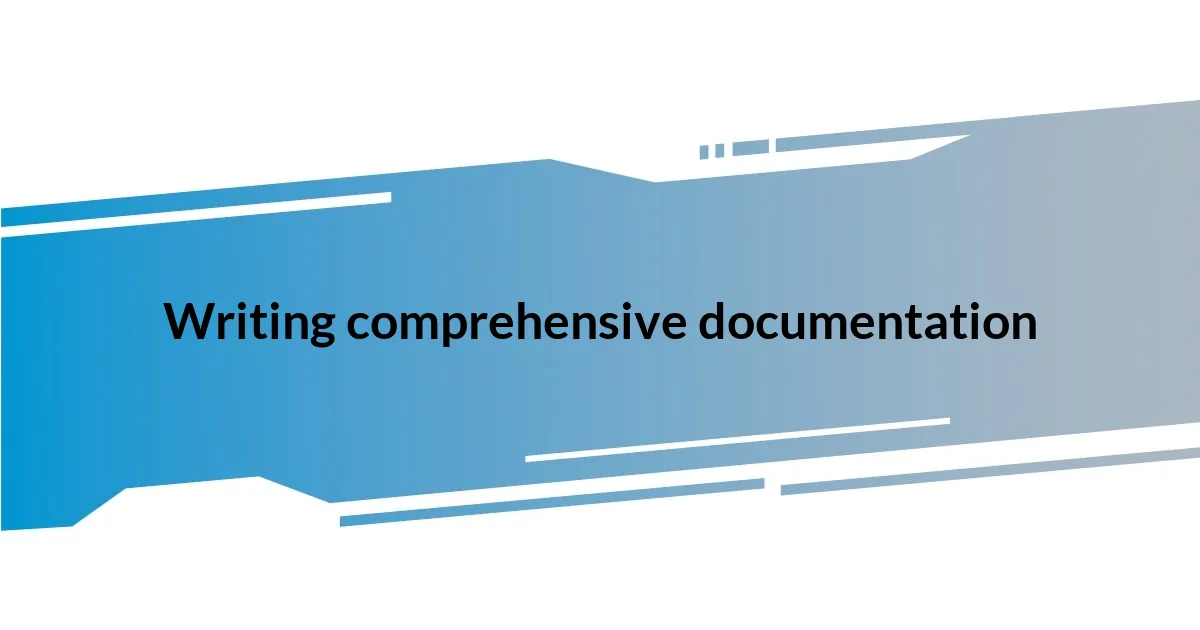
Writing comprehensive documentation
Writing comprehensive documentation is an often-overlooked aspect of backend development. I once embarked on a project where the documentation for the existing codebase was sparse and riddled with technical jargon. Navigating that was like trying to find my way through a foggy maze. I quickly learned that clear, concise documentation could drastically reduce onboarding time for new team members and even help seasoned developers when returning to a project after a break. Have you ever opened a project and felt completely lost? That’s the kind of confusion we can prevent with solid documentation.
In my experience, I’ve found that visual aids can enhance the clarity of documentation immensely. On a previous project, I integrated diagrams and flowcharts to depict complex processes. The moment I added those visuals, feedback from my teammates shifted from vague understandings to genuine “aha!” moments. It’s not just about writing; it’s about making information accessible. How often do we skim through walls of text without fully grasping the concepts? This approach has taught me the importance of making the content engaging rather than overwhelming.
Another key lesson I’ve internalized is the significance of keeping documentation up to date. There was a time when I neglected this, and as a result, the project suffered. Outdated documentation led to mistakes that could have been easily avoided. Now, I advocate for treating documentation as a living entity, one that evolves alongside the code. It might feel tedious, but wouldn’t you agree that investing a little time regularly saves a heap of confusion later on? In essence, I’ve realized that writing comprehensive documentation not only enhances collaboration but also elevates the quality of the code itself.
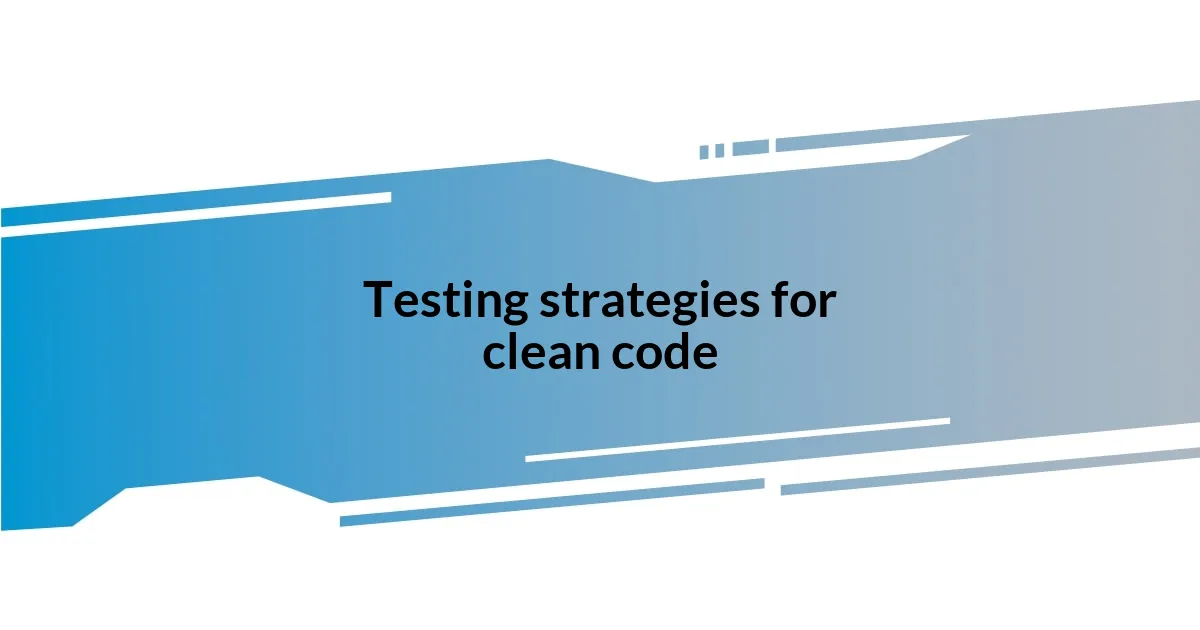
Testing strategies for clean code
Testing strategies are central to maintaining clean backend code, and I can’t emphasize enough how these methods can transform your coding experience. Early on in my career, I adopted Test-Driven Development (TDD) and found it incredibly beneficial. By writing tests before the actual code, I was able to clarify requirements upfront. It felt like crafting a blueprint before construction—everything fell into place more smoothly when I had a clear foundation to build upon.
Another strategy that profoundly impacted my coding style is the practice of Continuous Integration (CI). At first, I was skeptical about the overhead it seemed to add, but after implementing it in a recent project, I realized how reassuring it was. Automated tests ran with every code change, instantly identifying issues before they snowballed into larger problems. It was a relief, almost like having a safety net under me while I explored new code. Can you recall a time when you caught a bug just in the nick of time? That thrill of catching mistakes early can’t be overstated.
Moreover, incorporating exploratory testing has added depths to my testing approach. Unlike standard tests that look for specific outcomes, exploratory testing allows you to discover unexpected behaviors. I remember taking a Friday afternoon to dive deep into a feature, and while testing it outside of the usual parameters, I found a significant flaw that could have jeopardized the release. That experience reinforced my belief that testing isn’t just a checklist—it’s an insightful journey that contributes to cleaner, more reliable backend code. How often do we prioritize the planned over the potential? Embracing diverse testing strategies can elevate our code quality to new heights.